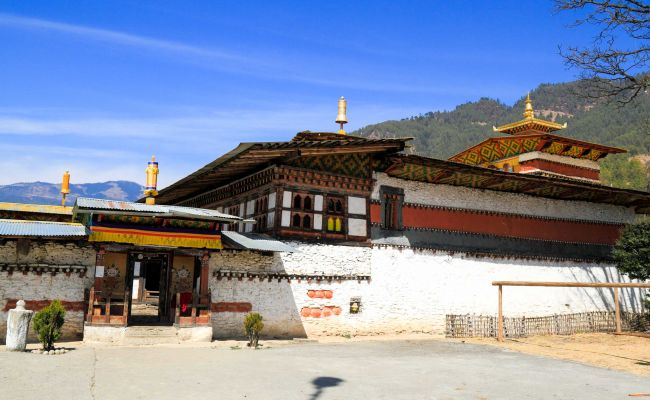Tamzhing Lhündrup Monastery, located in central Bhutan’s Bumthang District, is a Nyingma gompa. Its temple and monastery are notable for their close ties to the Bhutanese tertön and saint, Pema Lingpa (1450–1521) and his tulku. It is now the residence of Sungtrul Rinpoche, the current spoken incarnation of Pema Lingpa.
Tamzhing has a crumbling temple and a cramped vihara. It houses more than 95 Buddhist monks. The monastery submitted its application for inscription on the World Heritage Sites in March 2012 and is currently on the tentative list.
Tamzhing Monastery History
The temple was built by Pema Lingpa in 1501; the coeval wall paintings include his portrait and are amongst the earliest in the country.
Before 1960 Tamshing was a privately owned temple (like many other temples in Bhutan). After Pema Lingpa died in the temple at the age of seventy-two in 1521, his descendants took over care of the temple. Gradually, over many years, Tamshing fell into a state of disrepair and neglect. The temple courtyard was used as a granary and local people came less and less, except for special days.
In 1959, when many Tibetans (including the present Dalai Lama) fled their country for fear of being killed quite a few came to the Bumthang region, which is the cradle of Buddhism in Bhutan.
In his time, Pema Lingpa received a vision to travel to Tibet where he revealed a treasure hidden by Guru Rinpoche (Padmasambhava) many centuries before. He was given land in the Longti area of the Siti Valley and built a temple there which is called Lhalung. This temple was later enlarged by his third (Tibetan) incarnation. Pema Lingpa traveled frequently to Tibet and most of his incarnations were Tibetan.
The 10th incarnation of Pema Lingpa died in Tibet shortly before the Tibetan diaspora. In 1960, a group of three monks from the Lhalung monk body headed by Lhalung’s second in command, Thinley Kuenchap (d. 1975) came to Tamshing to reestablish the Lhalung monk body at Tamshing.
Lopen Thinley Kuenchap was well known to the exiled Tibetan monks in Bhutan. Hearing of his arrival at Tamshing, many gathered there in late 1960 and established the current monk body. Over time, this group has grown from 10 or 15 monks to over 95.
When the Khudun, Lopen Kharma, came to Tamshing as a young boy in 1980, most of the senior monks from Tibet had passed on, however, Lopen Tseten who came from Tibet to Tamshing as a 10-year-old monk in 1960 was still there. Today, Lopen Tseten is the head of the monastery organization and its senior teacher.
The present spiritual head of Tamshing is the 11th incarnation of Pema Lingpa, the Lama Sungtrul Rinpoche (speech incarnation) he was born in the Chumi Valley of Bumthang, Bhutan in 1967.
Importance
Terton Pema Lingpa, Bhutan’s great ‘Treasure Revealer’ and a significant historical figure, has a direct relationship with the Tamzhing monastery. The monastery is Pema Lingpa’s primary seat and serves as unique evidence of the Peling tradition’s continuing teachings in Bhutan.
Tamzhing monastery is also where the sacred dances of Peling traditions began. The dances have a strong connection to Bhutan’s living cultural tradition, making it a significant site for both tangible and intangible heritage.
Tamzhing Monastery is an outstanding example of Bhutan’s unique architectural style. It was built in the location where Guru Rinpoche (Padmasambhava) meditated and sanctified, and it represents the landscape stages of Tamzhing monastery. They hold immense significance for Bhutan and the global community, symbolizing the ongoing practice of a significant Buddhist tradition that provides religious services to both Bhutanese and Buddhists worldwide.
